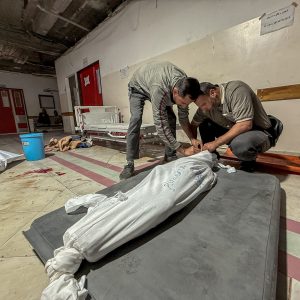A long haul: reconstruction of Gaza a year after war
Gaza City, Palestinian Territories-
A year after its devastating war with Israel, the Palestinian resistance movement Hamas is faced with a dilemma: to keep up the resistance struggle or to lay low and reconstruct the Gaza Strip?
On May 10, 2021, the storming of the Al-Aqsa mosque compound by Israeli forces led to violent clashes in east Jerusalem resulting in the killing of scores of Palestinians and culminating in all-out conflict.
Reacting to the violence by Israeli security forces at Al Aqsa compound, Palestinian groups fired rockets. Although most of these were intercepted by the Israeli Defense system, that same evening the Israeli air force pounded Gaza.
What followed was 11 days of war that leveled parts of Gaza, killing 260 Palestinians including civilians and children. 72,000 were rendered homeless and internally displaced in Palestine.
More than 1,000 housing units and buildings in Gaza were damaged or completely destroyed by the Israeli bombardment.
A year later, the reconstruction effort has barely taken off.
Gaza City’s destroyed towers have not been rebuilt, and many roads are still in dire need of repair.
“By the middle of this year we should have completed the reconstruction of 500 houses,” Naji Sarhan, undersecretary of Gaza’s public works ministry said.
“Our priority is to rebuild the apartments of low-income families”, said Sarhan, whose ministry is under Hamas control.
He said reconstruction aid was provided by Egypt and Qatar, the two Arab countries which mediated the truce between Hamas and Israel.
– Hamas ‘divided’ –
With no political solution on offer, the tension continues in the region. The economic situation in Gaza is deplorable, with rampant unemployment at around 50 percent.
With mounting international pressure to ease restrictions on Gaza, the number of permits for Gazans to work in Israel was increased to 12,000 in early April. Israel also promised 20,000 more ‘if the situation remains calm.’
However, with the recent Israeli storming of Al Aqsa again this year, the ‘calm’ is no more. The violence at Al Aqsa has led to six reactionary attacks targeting Jewish settlers, followed by mass arrests and demolitions by Israel in retaliation and ‘collective punishment.’ Hamas has threatened a “big battle” if Israel continues its aggression against Palestinian worshippers in Al-Aqsa.
“Hamas is divided. The leadership in Gaza is trying to avoid further escalation and is encouraged by the decision of the current Israeli government to give more permits to Gaza as long as Gaza remains quiet,” said Middle East expert Ofer Zalzberg from the Herbert C. Kelman Institute.
“But there are also Hamas leaders outside Gaza, like Saleh al-Arouri, who think more in terms of ideology and believe that the strategy should not focus on Gaza,” he said.
For Palestinian economist Omar Shaban, the reconstruction and development of Gaza cannot depend alone on donations from foreign countries or work permits granted by Israel.
“We need a real political process… which will raise the question of the recognition of the entity that administers Gaza”, he said, referring to Hamas, which is branded a “terrorist” organization by the United States, EU and Israel.










